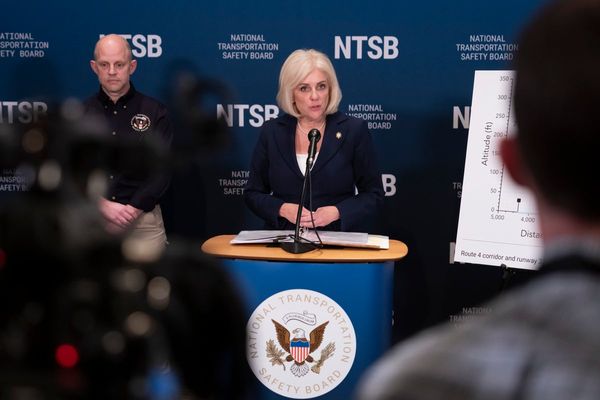The Metaverse, the alt-reality world pumped by high profile advocates like Facebook’s Mark Zuckerberg, may be a world that real people don’t want.
Stock market investors may want to start paying attention, before they pour big dollars into the technology.
TheStreet’s Managing Editor Daniel Kline has the story.
“Nobody doubts that the Metaverse has its uses, but Mark Zuckerberg believes in it so much he has bet Facebook's future on it to the point of renaming his company Meta (FB). That would be like if Amazon (AMZN), which filed for a number of 3D printing patents, had ditched its name and become 3DP,” Kline wrote.
Zuckerberg might be wrong, Kline noted – and at least one prominent CEO put the brakes on the metaverse enthusiasm during a recent television appearance.
Expedia (EXPE) CEO Peter Kern thinks that people will actually remain more interested in the real world. “I don’t see [the metaverse] as a competitive threat. We’re certainly, like everyone else in the world, sort of intrigued by it … but we’re pretty much about the ‘real-verse,’” Kern said in an interview with CNBC.
The CEO added that he did not expect virtual experiences to replace real experiences. "I don’t think the metaverse, in my lifetime, will ever make up for being in Paris, being in Rome, being in a National Park," he said. "There is just no replacement for that, and those experiences are what changes our lives. And I don’t think that’s the same with a headset on, on your couch."
The defining quality of the metaverse will likely be a feeling of presence — like you’re right there with another person or in another place. Feeling truly present with another person is the ultimate dream of social technology. Tech execs like Zuckerberg want to capitalize on that.
“In the metaverse, you’ll be able to do almost anything you can imagine — get together with friends and family, work, learn, play, shop, create — as well as completely new experiences that don’t really fit how we think about computers or phones today,” Kline wrote.
“Or, people will still "get together with friends and family, work, learn, play, shop, create," and more the same way they do today,” he added. “Yes, the metaverse will exist -- just like Zoom calls exist for when getting together isn't convenient, but maybe most people don't want to give up reality for virtual reality?”
Kern certainly believes that’s the case.
"Maybe I’ll be wrong," he said. "Maybe in 100 years we will all be batteries, and sitting around with headsets on, but for the foreseeable future we feel pretty good about people wanting to be out in the world,” he said.
Here in the real world, TheStreet’s market experts are probing some intriguing stocks this week -- here’s a few of them for trading consideration.
SoFi Technologies SOFI $12.38. 5-day performance 2.39%.
TheStreet’s Bruce Kamich is shining a light on SoFi Technologies (SOFI), a major digital financial services company.
“A sell-side firm just initiated coverage of SoFi Technologies with a buy recommendation,” Kamich said. “So the company is worth checking out again.”
In a review last month, Kamich wrote that "SOFI may capture more customers across the USA but the charts are not favorable at this point in time. SOFI may not sink to $5, but it needs to make a base pattern before it becomes attractive to technically oriented traders. Avoid."
Now, the daily bar chart shows prices have "chopped around" since the January review.
“Prices are still below the declining 50-day moving average line,” Kamich wrote recently. “The 200-day moving average line also has a negative slope. The trading volume has been heavy since the middle of January and could be a changing of positions from weak hands to stronger hands.”
Kamich said he sees a more positive-looking picture than in January.
“Now we see a bullish pattern in January with bullish confirmation the following week,” he said. “This bottom reversal pattern could result in a rally or it could mean that prices trade sideways. SOFI is trading below the declining 40-week moving average line but the strength of the downtrend is waning.”
It looks like SOFI has made a low for now.
“In the short-run prices could make a bounce to the $16 area but ideally I would like to see SOFI trade sideways and build a base that could support a sustained advance,” Kamich said. “Scalpers could buy SOFI at current levels for a bounce. Risk to $11.05.”
AT&T Inc. T $24.17. 5-day performance 0.46%.
AT&T (T) is in the news this week, but not for the best of reasons.
“After telegraphing the move nearly a year ago, AT&T Inc. recently announced that it would be slashing its annual dividend by close to 90% from the prior year due to an upcoming spinoff of its Time Warner assets,” said Real Money's Bob Ciura.
The company had a dividend growth streak of more than 30 years prior to that. “AT&T now joins the list of other fallen Dividend Aristocrats whose business decisions didn't work out, costing them the ability to continue to raise distributions to shareholders,” Ciura noted.
Ciura believes the market has clearly soured on AT&T for the moment, and perhaps rightfully so. But the future might not be all that bleak for the company.
“There are several factors working in AT&T's favor that we feel make a compelling investment thesis, especially after the shares have pulled back,” he said.
First up is that, up until recently AT&T had been a darling of the dividend growth investment community. That’s also for good reason as the stock had an average annual dividend yield below 4.5% only one time since 2005. The stock's average yield for the last decade approached 6%.
“Dividend growth was never that impressive, just slightly more than 2% on average since 2011 and earnings growth had been anemic, but the amount of income provided was the tradeoff for many investors,” Ciura said. “But then the unthinkable occurred. On May 17th, 2021, AT&T announced that it would combine its WarnerMedia assets with Discovery Inc. (DISCA)DFL to create a new global entertainment company.”
Simultaneously, the company announced that it expected its dividend payout ratio to be approximately 40% of free cash flow remaining following the spinoff. “The WarnerMedia assets were expected to make AT&T even more of a cash cow than it was at the time of purchase,” Ciura said. “And this was the case, with free cash flow reaching nearly $30 billion.”
However, leadership projected free cash flow to be $20 billion in the first year following the mid-2022 separation. “Unfortunately, this provides just $8 billion for dividend payments, which equated to roughly $1.15 per share or so based on the share count at that time,” Ciura noted. “This would mean a drastic reduction in the dividend for a stock that was largely held for its income generation. The shares plummeted on the initial announcement.”
The shares went down nearly 5% again on the announcement that the new annualized dividend would be for $1.11. That represents an 87% reduction in dividend payments compared to the prior year. Additionally, in the short-term, there are some issues that remain with the company.
“The acknowledgement of previous poor acquisitions resulted in the cutting the company's dividend,” Ciura said. Investors relying on AT&T's dividend, which had appeared quite safe, are going to feel the impact of the cut. It’s never good when a company known for low growth, but high yield ends up cutting its dividend.”
Ciura does see some positives working in AT&T's favor that he thinks long-term investors should consider before selling their positions.
--- First, the spinoff of WarnerMedia will return AT&T more to its roots as a pure-play telecommunications company, with this perhaps the best moment to do so.
--- 5G is going to be a substantial tailwind to the telecommunications sector in general, but AT&T in particular. We are very much in the early innings of 5G, but already there have been clear benefits.
--- In the most recent quarter, AT&T added 1.3 million net additions, including 884,000 phone net additions. This is a massive influx of customers and tops even rival Verizon Communications' (VZ) total of 1.06 million net additions and 558,000 postpaid phone net adds.
--- Just as important as acquiring new customers is the ability to retain the current customer base. Here, AT&T shows its strength as the churn ratio for the quarter was just 0.85%, up slightly from a record level in the prior year. Customer retention is hugely important as it shows consumers value the service being provided.
--- AT&T also extracts significant revenue from its user base. The most recent quarter saw average revenue per user fall slightly, but remains at a solid level of $54.06.
--- AT&T's Wireless Service segment grew 4.6% in the fourth quarter of 2021, a positive showing for what will likely be an even more important business within the company. While leadership may have mismanaged acquisitions, it appears that they are leveraging its core business to the benefit of the company.
--- AT&T acquired the WarnerMedia assets in 2016, but at a significant cost to the balance sheet. Total debt from this transaction and other acquisitions that haven't worked out as planned, such as DirecTV, saddled AT&T with a burdensome debt amount that was approaching $200 billion. To illustrate how much debt the company took on, AT&T's market capitalization is just $175 billion today.
“We continue to expect that AT&T will earn $3.10 per share for 2022,” Ciura said. “With the stock trading around $24.50, this implies a price-to-earnings ratio of 7.9. Our five-year target valuation is 10 times earnings, which is lower than the long-term average.”
“This multiple is appropriate, in our opinion, given the slowdown in earnings growth in the recent term,” he added. “Reverting to our target valuation would mean that multiple expansion adds 4.8% to annual returns over the next five years.”
Lastly, the dividend will continue to be important to total returns. Even at the reduced payment, AT&T yields 4.5%, which is more than three times the average yield of the S&P Index.
“Therefore, our total return projection is 10.4%, stemming from a 2% earnings growth rate, 4.5% dividend yield, and a mid-single-digit contribution from multiple expansion,” he added.
Even after the dividend cut, Ciura still forecasts that AT&T can provide more than 10% annual returns over the next half-decade.
“For investors willing to see past the dividend cut, AT&T could prove to be a solid investment going forward,” he said.
Caesars CZR $81.23. 5-day performance 0.59%;
MGM Resorts MGM $44.65. 5-day performance (-2.10%).
The Los Angeles Rams 23-to-20 victory over the Cincinnati Bengals in the Super Bowl shook the gambling markets, with billions of dollars laid on the line by sports wagering enthusiasts.
The week, however, was even a bigger win for two big gambling stocks – Caesars (CZR) and MGM Resorts (MGM).
“The Super Bowl marked Las Vegas's official return to normal,” Kline reported. “It was the first major event held in the city since Nevada dropped its indoor mask mandate. That removed a major barrier for people wanting to visit the city famous for excess, not for carefully managing a pandemic."
That led to a “huge weekend” for Caesars, MGM Resorts, and other Las Vegas sportsbooks. A record 31.4 million American adults planned to bet on Super Bowl LVI, a 35% increase from 2021, according to new American Gaming Association research.
“It's a massive comeback after last year's pandemic-hit game with bettors expected to wager "an estimated $7.61 billion on this year’s championship game, up $3.33 billion (78%) from last year,” the AGA reported.
“That number was likely exceeded with the late lifting of the mask mandate and the huge pent-up demand caused by nearly two years of restrictions that even Las Vegas -- a city not known for playing by the rules -- could not ignore,” Kline wrote.
Why was the Super Bowl a big win for Las Vegas?
“Most bets on the actual game are against "the line,” Kline said. “That means that people bet on a team plus or minus however many points bookmakers think it will win or lose by. For the Super Bowl, the line actually moved toward Los Angeles as the favorite about three days before the game, Sports Illustrated reported.
The Los Angeles Rams ended up beating the Cincinnati Bengals 23-20. That's a victory margin of 3, meaning that L.A. won, but it did not cover the spread. The total points scored also came in at 43, still well under the 48.5 that was predicted.
Those are important distinctions for sportsbooks.
"The ideal scenario for sportsbooks in the Super Bowl is usually for the favorite to win but not cover and for the game to go under the total," the Las Vegas Review-Journal reported.
Basically, while Las Vegas sportsbooks take a cut of every bet and win either way, the Super Bowl created a situation where Vegas won even bigger.
“Ideally, the oddsmakers set the line and over/number so an equal number of bettors place money on each side of the bet. In this case, that's not what happened and more gamblers placed their money on the losing side of the equation -- a rare huge win for the sportsbooks,” Kline said.
Perhaps most important, this weekend in February sets the standard for a return-to-normal college basketball and March Madness.
“The NCAA tournament generally stands as the largest cumulative betting event for Las Vegas casinos,” Kline said. “And after the tournament was canceled in 2020 and returned on a very muted basis last year, this year's March Madness may very well bring Vegas's casinos all the way back to where they were before Covid.”
Rising interest rates, inflation and market volatility are on the horizon. You don’t want to miss out on this exclusive opportunity to unlock Action Alerts PLUS at our lowest price of the year.







